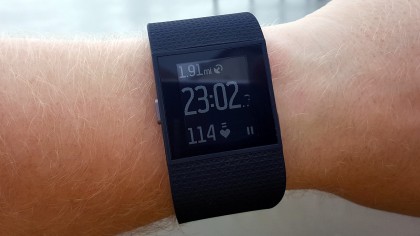Why you can trust TechRadar
As running watches go, the Fitbit Surge once had a fairly standout in design, hailing from somewhere in the smartwatch direction, but the style stakes have been seriously upped since launch with the like of the Garmin Forerunner 645 really taking style to a whole new level.
The tracking element has been dragged across to the Surge, along with GPS and HR tracking to give you a fuller picture of your performance.
It's immediately obvious that this is more of a fashion item rather than a hardcore 'ultramarathon' tracker, which is by no means a bad thing.
Out of the box the Surge impresses with the speed of setup. Just charge, slap on wrist, hit the 'Run' option in the menu, confirm Free or Treadmill run (GPS on or off) and crack on.

The strap is a traditional strap and buckle affair allowing enough play for the HR sensor to read correctly, and stays neatly put in use.
The slightly canted screen makes glancing at stats mid-run a pleasure, and the slightly rounded contour of the back is comfy enough for long sessions.
The 'quick start' button let's you skip the 'standing on the pavement staring at a GPS icon' bit, which is nice.
The GPS itself picks up very rapidly indeed, getting a lock seconds after hitting the open air even in crowded central London.
We liked the vibrate alerts for pause/start and GPS lock, and if you're looking for other sports to track there's a plentiful selection on tap, from 'hiking', 'weights', 'elliptical', through to 'spinning', 'yoga' and a mysterious 'workout', the latter intended as a catchall.

While running, most of the screen real estate is fixed to distance and overall time, with just the bottom bar being swipe-able between HR, average pace, pace, clock, steps, calories.
For a smartwatch or fitness tracker that's fine, but for a pure running watch it's a little weak. The sensitivity of the screen to swipes seems variable, possibly due to the small area involved. The upshot is it's not easy to skip between stats on the move.
Heart Rate zone training is especially fiddly - it is possible to see which one you're currently operating in via a system of tiny dots, but it's not that easy to read on the move. It is possible to create HR zones of your own instead of using the defaults, (create in app or PC then sync), but you'll have to keep checking obsessively to stay on track.
You can receive call and text notifications while running, hit the top 'action button' to view alerts, home button to dismiss, and you can even control iOS music by double-pressing the Home button. However, there's no social pestering, and no calendar alerts, which is a double-edged sword in connectivity terms.
Accuracy wise the HR monitor is a mixed bag - tested back-to-back against a Suunto HR chest strap on one occasion it spent the first 2k or the run varying around 10-5BPM out of sync, while we fiddled with the position and strap tightness. Finally it settled down to track the chest belt accurately, albeit on a slight delay.

However, removing the Surge and replacing it triggered the same behaviour, in spite of our previous experience in positioning etc. Once setup correctly it's accurate enough, but getting that setup seems a little hit and miss, and if you're not in the habit of running with a chestbelt as a control you'll not know it's out of whack.
The GPS tracked us accurately, on the upside, and the Fitbit step counter algorithm was as generous as ever, with us hitting our 10k target before lunch some days.
Current page: What's it like as a running watch?
Prev Page Introduction, design and fitness metrics Next Page Heart rate monitor, sleep and smartwatch features
